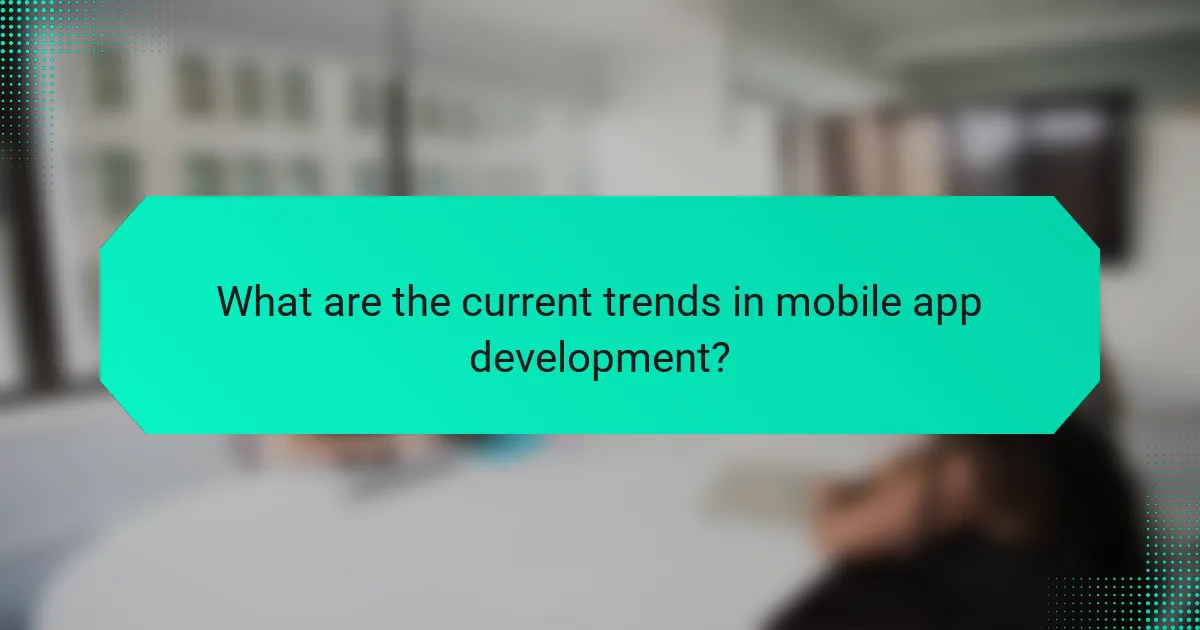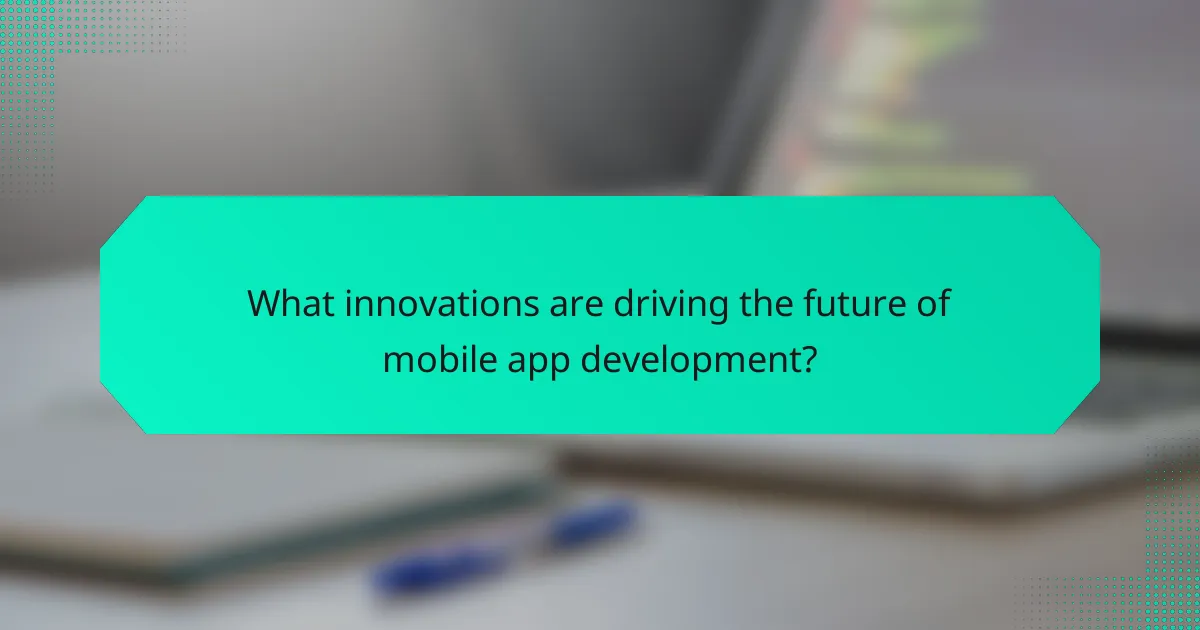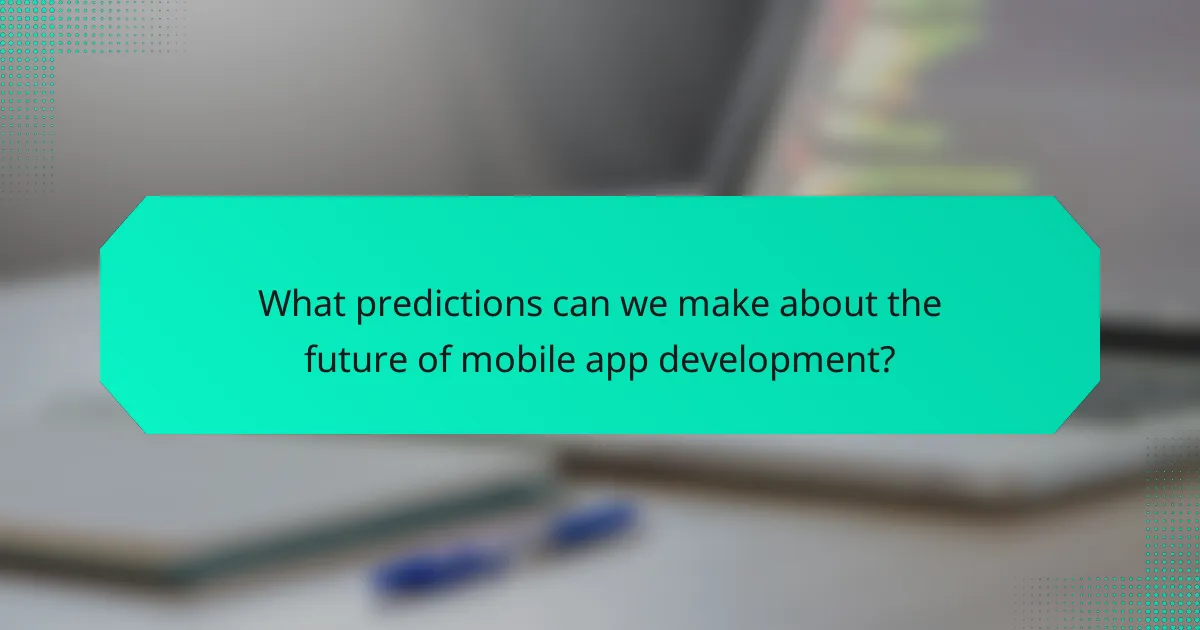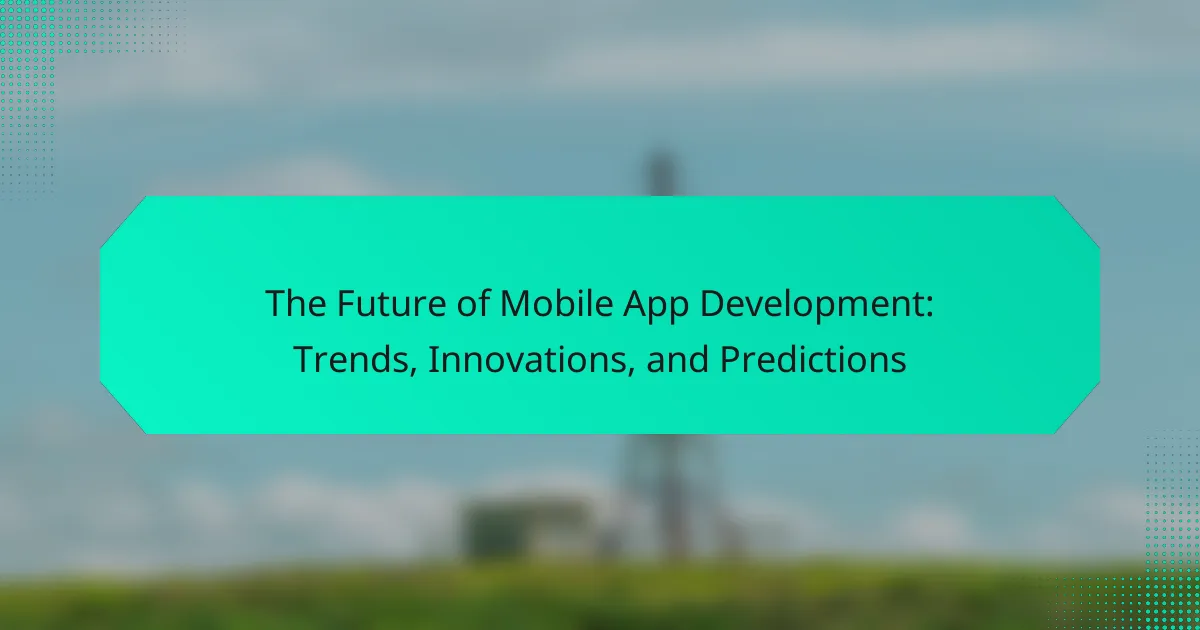The article focuses on the future of mobile app development, highlighting significant trends, innovations, and predictions shaping the industry. Key advancements include the integration of artificial intelligence (AI) and machine learning (ML) for enhanced user experiences and personalization, as well as the rise of augmented reality (AR) and virtual reality (VR) to create immersive interactions. The adoption of cross-platform development frameworks like Flutter and React Native is streamlining the app creation process, while the emergence of no-code and low-code platforms is democratizing app development for non-developers. Additionally, the article addresses the growing importance of app security and privacy in response to evolving cyber threats, as well as the increasing integration of Internet of Things (IoT) capabilities to connect apps with smart devices. Overall, these trends reflect a dynamic shift towards innovative, user-centric mobile applications.

What are the current trends in mobile app development?
Current trends in mobile app development include increased use of artificial intelligence, machine learning, and augmented reality. These technologies enhance user experience and personalization. The rise of 5G technology allows for faster data transfer and improved app performance. Cross-platform development frameworks like Flutter and React Native are gaining popularity for their efficiency. Additionally, there is a focus on app security and privacy, driven by user demand for data protection. The integration of Internet of Things (IoT) capabilities is also on the rise, allowing apps to connect with smart devices. Furthermore, no-code and low-code development platforms are emerging, enabling non-developers to create apps easily. These trends reflect the industry’s shift towards more innovative and user-centric solutions.
How is user experience influencing mobile app development trends?
User experience significantly influences mobile app development trends by prioritizing user-centric design. Developers focus on creating intuitive interfaces that enhance usability. This trend is driven by the need to improve user satisfaction and retention rates. Research shows that 88% of users are less likely to return to an app after a bad experience. Consequently, developers are adopting agile methodologies to iterate quickly based on user feedback. Furthermore, personalization features are becoming essential, as 80% of consumers are more likely to engage with personalized experiences. Overall, user experience shapes the direction of mobile app development by emphasizing ease of use and responsiveness.
What design principles are emerging in mobile app interfaces?
Emerging design principles in mobile app interfaces include minimalism, dark mode, and voice user interface (VUI) integration. Minimalism focuses on simplicity and functionality, reducing clutter for better user experience. Dark mode enhances visual comfort and battery life on OLED screens. VUI integration allows users to interact through voice commands, increasing accessibility. According to a 2022 study by Nielsen Norman Group, 70% of users prefer apps with minimalistic designs. These principles reflect current user preferences for intuitive and efficient interactions.
How do personalization and customization enhance user engagement?
Personalization and customization enhance user engagement by tailoring experiences to individual preferences. This approach increases relevance, making users feel valued and understood. According to a study by Epsilon, 80% of consumers are more likely to make a purchase when brands offer personalized experiences. Customization allows users to modify features, creating a sense of ownership. This involvement leads to higher satisfaction and retention rates. Research from McKinsey shows that companies that personalize experiences see a 10-30% increase in revenue. Overall, these strategies foster deeper connections between users and brands.
What role does technology play in shaping mobile app development trends?
Technology is a crucial factor in shaping mobile app development trends. It drives innovation in programming languages, frameworks, and tools. For instance, the rise of cloud computing has enabled developers to create scalable applications. This has led to increased demand for cloud-based services in mobile apps. Additionally, advancements in AI and machine learning enhance user experiences through personalization. Technologies like augmented reality (AR) and virtual reality (VR) are also transforming app functionalities. According to Statista, the global mobile app market is projected to reach $407.31 billion by 2026, reflecting technology’s impact. Continuous integration and delivery practices streamline development processes, making them more efficient. Thus, technology significantly influences both the capabilities and trends in mobile app development.
How are advancements in AI and machine learning impacting app functionality?
Advancements in AI and machine learning are significantly enhancing app functionality. These technologies enable apps to provide personalized user experiences. For instance, AI algorithms analyze user data to tailor content and recommendations. Machine learning improves predictive analytics, allowing apps to anticipate user needs. This leads to more efficient interactions and streamlined processes. Furthermore, AI-powered chatbots enhance customer support within apps. They provide instant responses and solutions, improving user satisfaction. According to a 2021 report by Gartner, AI will power over 75% of mobile apps by 2025. This demonstrates the increasing reliance on AI and machine learning in app development.
What is the significance of cloud computing in mobile app development?
Cloud computing is significant in mobile app development as it enhances scalability, flexibility, and cost-effectiveness. It allows developers to build applications that can easily scale to accommodate varying user demands. According to a report by Gartner, over 70% of enterprises plan to increase their cloud spending in the coming years. This trend illustrates the growing reliance on cloud services in app development. Additionally, cloud computing facilitates real-time data synchronization across devices, improving user experience. It enables developers to focus on core functionalities instead of infrastructure management. Furthermore, cloud platforms provide access to advanced tools and technologies, fostering innovation in app features.

What innovations are driving the future of mobile app development?
Artificial intelligence and machine learning are driving the future of mobile app development. These technologies enable apps to provide personalized experiences and automate tasks. For instance, AI-powered chatbots enhance customer service within apps. Additionally, augmented reality (AR) and virtual reality (VR) are transforming user engagement. They allow users to interact with digital content in immersive environments. Cross-platform development frameworks like Flutter and React Native are streamlining the development process. These frameworks enable developers to create apps for multiple platforms from a single codebase. Cloud-based services are also facilitating scalability and performance. They allow apps to handle increased user loads efficiently. Lastly, the Internet of Things (IoT) integration is expanding app functionalities. This innovation connects apps to a network of devices, enhancing user experience.
How are emerging technologies transforming mobile applications?
Emerging technologies are significantly transforming mobile applications. Technologies such as artificial intelligence, machine learning, and augmented reality enhance user experience. AI enables personalized content and recommendations, improving user engagement. Machine learning algorithms analyze user data for smarter app functionality. Augmented reality creates immersive experiences, particularly in gaming and retail sectors. Blockchain technology enhances security and transparency in transactions. 5G connectivity allows for faster data transfer and improved app performance. These advancements lead to innovative features and increased user satisfaction in mobile applications.
What impact does augmented reality have on user interaction in apps?
Augmented reality significantly enhances user interaction in apps. It creates immersive experiences that engage users more deeply. Users can visualize information in real-time and interact with digital elements in their physical environment. This interaction increases user satisfaction and retention rates. A study by Deloitte found that 83% of users prefer apps with AR features. Such features can lead to higher conversion rates in retail apps. AR also facilitates intuitive navigation and learning in educational apps. Overall, augmented reality transforms how users interact with mobile applications.
How is the Internet of Things (IoT) integrating with mobile applications?
The Internet of Things (IoT) integrates with mobile applications by enabling remote control and monitoring of smart devices. Mobile apps serve as interfaces for users to interact with IoT devices. This integration allows for real-time data collection and analysis. For example, smart home applications let users manage lighting, heating, and security systems from their smartphones. IoT devices generate data that mobile apps can visualize and utilize for user insights. According to a report by Statista, the number of connected IoT devices is expected to reach 30.9 billion by 2025. This growth drives the demand for mobile applications that can manage these devices effectively. Thus, the synergy between IoT and mobile apps enhances user experience and operational efficiency.
What new development frameworks are gaining popularity?
Flutter and React Native are two new development frameworks gaining popularity. Flutter, developed by Google, allows for cross-platform app development using a single codebase. It has seen a rise in adoption due to its fast performance and expressive UI capabilities. React Native, created by Facebook, enables developers to build mobile apps using JavaScript. Its popularity stems from a large community and reusable components. According to a 2023 Stack Overflow survey, both frameworks ranked among the top choices for mobile development. Their growing ecosystems and strong support contribute to their increasing prevalence in app development.
How do cross-platform frameworks improve development efficiency?
Cross-platform frameworks improve development efficiency by allowing developers to write code once and deploy it across multiple platforms. This reduces the time and resources needed for separate development for iOS and Android. Developers can maintain a single codebase, which simplifies updates and bug fixes. The use of shared libraries and components further accelerates the development process. According to a study by Statista, 42% of developers prefer cross-platform frameworks for their efficiency. This approach also enhances collaboration among teams, as they can work on the same codebase simultaneously. Overall, cross-platform frameworks streamline the development lifecycle, making it faster and more cost-effective.
What advantages do low-code/no-code platforms offer developers?
Low-code/no-code platforms offer significant advantages to developers. They enable rapid application development, reducing the time needed to build software. Developers can focus on complex tasks while automating routine processes. These platforms often provide visual interfaces, making it easier to design applications without extensive coding knowledge. They also facilitate collaboration between technical and non-technical team members. This leads to increased productivity and efficiency in project delivery. According to a report by Gartner, low-code development will account for over 65% of application development by 2024. This trend highlights the growing importance of low-code/no-code solutions in the software development landscape.

What predictions can we make about the future of mobile app development?
Mobile app development will increasingly focus on artificial intelligence and machine learning. These technologies will enhance user experiences and personalize app functionalities. The integration of augmented reality and virtual reality will also rise. This shift will create immersive experiences for users in various applications. Cross-platform development will gain traction, allowing developers to create apps for multiple platforms simultaneously. This approach will save time and resources. Additionally, the demand for app security will intensify as cyber threats evolve. Developers will prioritize secure coding practices and data protection measures. The use of low-code and no-code platforms will democratize app development. This trend will empower non-developers to create applications easily. Overall, these predictions reflect a dynamic landscape for mobile app development driven by technological advancements and user needs.
How will user expectations evolve in the coming years?
User expectations will evolve towards greater personalization and seamless experiences in mobile apps. As technology advances, users will demand more tailored content and features. Increased integration of artificial intelligence will enable apps to predict user needs effectively. Additionally, a focus on privacy and data security will shape user preferences. Users will expect apps to provide instant support through chatbots and customer service features. The rise of 5G technology will lead to demands for faster performance and enhanced functionalities. Moreover, users will increasingly seek intuitive designs that require minimal learning curves. This shift reflects a broader trend towards convenience and efficiency in digital interactions.
What features are likely to become standard in future mobile apps?
Future mobile apps are likely to standardize features such as enhanced security, AI integration, and improved user interfaces. Enhanced security will include biometric authentication and end-to-end encryption. AI integration will enable personalized experiences and predictive analytics. Improved user interfaces will focus on intuitive design and accessibility. Additionally, features like dark mode and offline functionality are expected to become common. The demand for seamless cross-platform compatibility will also rise. According to a 2022 report by Statista, 90% of mobile users prefer apps that prioritize user experience. This trend indicates a shift towards user-centric design in future app development.
How will security concerns shape future app development practices?
Security concerns will significantly influence future app development practices. Developers will prioritize security features during the design phase. This shift will lead to the integration of advanced encryption methods. Enhanced authentication processes will become standard practice. Compliance with data protection regulations will be strictly enforced. Regular security audits will be part of the development lifecycle. User education on security best practices will be emphasized. As cyber threats evolve, adaptive security measures will be implemented. These changes will ensure apps are resilient against emerging vulnerabilities.
What market trends should developers watch for in the future?
Developers should watch for the rise of artificial intelligence in mobile app development. AI integration enhances user experiences through personalized content and predictive analytics. The global AI market is projected to reach $190 billion by 2025, indicating substantial growth. Additionally, cross-platform development tools are gaining traction. They allow developers to create apps for multiple platforms from a single codebase, improving efficiency. The market for cross-platform tools is expected to grow at a CAGR of 22.1% from 2021 to 2028. Furthermore, the demand for augmented reality (AR) and virtual reality (VR) applications is increasing. By 2024, the AR market is anticipated to reach $198 billion, driven by gaming and retail sectors. Lastly, the emphasis on app security is becoming critical. With increasing data breaches, developers must prioritize secure coding practices and compliance with regulations like GDPR.
How will the demand for mobile apps change across different industries?
The demand for mobile apps will increase significantly across various industries. Industries such as healthcare are adopting mobile apps for telemedicine and patient management. Retail is leveraging mobile apps for enhanced customer engagement and e-commerce solutions. Education is integrating mobile apps for remote learning and interactive content delivery. Financial services are utilizing mobile apps for banking and investment management. The global mobile app market is projected to reach $407.31 billion by 2026, growing at a CAGR of 18.4% from 2019. This growth is driven by the need for convenience and accessibility in everyday tasks. As technology advances, industries will continue to innovate, further increasing the demand for mobile applications.
What economic factors could influence the mobile app development landscape?
Economic factors that could influence the mobile app development landscape include market demand, investment levels, and economic stability. Market demand drives the need for innovative applications. High consumer spending on mobile technology can lead to increased development opportunities. Investment levels from venture capitalists and tech companies can enhance funding for new projects. Economic stability affects consumer confidence and spending habits. For instance, during economic downturns, businesses may reduce app development budgets. Conversely, a booming economy can lead to more investments in mobile solutions. These factors collectively shape the growth and evolution of the mobile app development industry.
What best practices should developers adopt for future mobile app success?
Developers should adopt user-centered design principles for future mobile app success. This approach prioritizes user needs and preferences throughout the development process. Conducting regular user testing helps identify usability issues early. Incorporating feedback into design iterations enhances user satisfaction. Additionally, ensuring cross-platform compatibility increases the app’s reach. Utilizing agile development methodologies allows for flexibility and quick adaptation to changes. Developers should also focus on performance optimization to improve load times and responsiveness. Security measures must be integrated from the start to protect user data. Finally, keeping up with industry trends ensures relevance in a competitive market.
How can developers stay updated with the latest trends and technologies?
Developers can stay updated with the latest trends and technologies by following industry news, participating in online communities, and attending conferences. Regularly reading tech blogs and subscribing to newsletters helps in gaining insights. Engaging with platforms like GitHub and Stack Overflow fosters collaboration and knowledge sharing. Online courses and webinars provide structured learning opportunities. Following influential figures on social media keeps developers informed about emerging technologies. Participating in hackathons encourages hands-on experience with new tools. Joining professional organizations offers networking opportunities and access to resources. Continuous learning is essential in the rapidly evolving tech landscape.
What strategies can enhance user retention in mobile applications?
Personalization enhances user retention in mobile applications. Tailoring content and experiences to individual users increases engagement. For example, personalized notifications can lead to a 20% increase in user retention rates. Gamification strategies, such as rewards and challenges, also boost user loyalty. Research shows that apps incorporating gamification see a 30% increase in active users. Regular updates with new features keep the content fresh and encourage users to return. Additionally, providing excellent customer support fosters a positive user experience. Studies indicate that 70% of users prefer apps with accessible support options. Lastly, utilizing user feedback for improvements creates a sense of community and ownership, enhancing retention further.
The main entity of the article is mobile app development. This article explores the current trends, innovations, and predictions shaping the future of mobile app development, emphasizing the integration of artificial intelligence, machine learning, and augmented reality to enhance user experience. It discusses the impact of user-centric design, emerging technologies, and cross-platform frameworks on development efficiency and user engagement. Additionally, it highlights the significance of cloud computing, security concerns, and the evolving expectations of users, providing a comprehensive overview of the mobile app development landscape.


